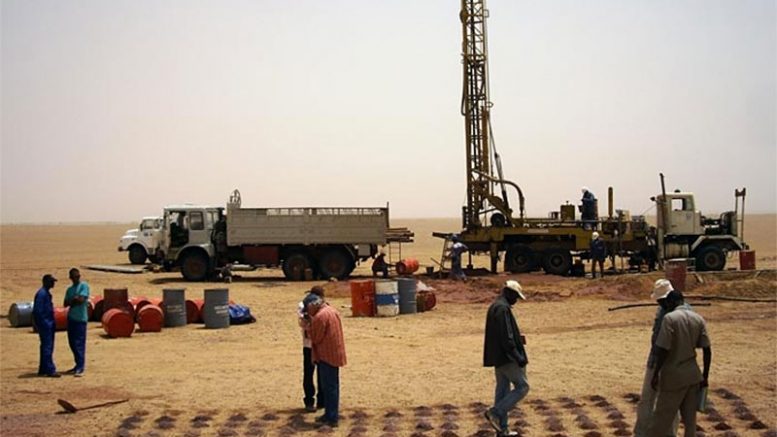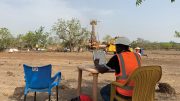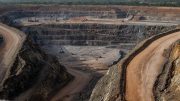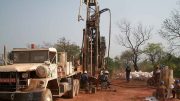GoviEx Uranium (TSXV: GXU; US-OTC: GVXXF) received the permits needed to build its flagship Madaouela project in Niger three years ago, but lagging uranium prices have kept development in check.
In the meantime, the Vancouver-based junior has been optimizing the project as part of a definitive feasibility study, talking with potential off-takers and financiers, and putting together a framework agreement with the government of Niger, which could be ready by the end of June.
The framework would see the Niger government take a 10% working interest in the project, in addition to its 10% free-carried interest under the country’s 2006 mining code.
The government would buy the 10% stake by converting US$14.5 million of debt GoviEx owes the state into equity, which would leave GoviEx debt free.
GoviEx has a right of first refusal to acquire Niger’s 10% working interest should the government ever wish to sell it, and the company won’t have to pay taxes until it finishes project financing for construction. Other terms include expanding the company’s Madaouela 1 mining permit to include previous resources GoviEx found on its Agaliouk permit, which will add 5.96 million lb. uranium oxide (U3O8) in the measured and indicated category.
GoviEx will also be granted renewed permits for another nine years for its Madaouela 2, 3 and 4, and Anou-Melle exploration permits, which had reached the end of their exploration periods.
Daniel Major, GoviEx’s president and CEO, says the government negotiated “sensibly,” and that it recognizes the uranium price has to move higher before the project is built.
It also recognizes that the country needs to replace Areva’s (now Orano’s) Cominak mine, which is next to the Madaouela project, and produces uranium oxide at a price higher than the selling price. Cominak could reach the end of its mine life over the next 12 to 24 months, according to Major.
“Sixty percent of Niger’s exports, from a value point of view, are uranium, and they need a replacement for Cominak,” Major says in a telephone interview from the United Kingdom. “We’re permitted, and the logical guys to come next.

GoviEx Uranium personnel at the Madaouela uranium property in Niger. Credit: GoviEx Uranium.
“They’d like to see us lined up as the next project, but the government is also pretty sensible about commerciality,” he continues. “The mines minister was very clear in his statement that Cominak is closing because it’s not commercial. It’s such an old mine, and it costs them more to mine it than the price they’re getting. They know they can’t just build a mine for the sake of it.
“We both know what we want to achieve,” Major says of GoviEx’s framework agreement. “We’ve worked long and hard with the government, and always communicated with them. The key part is, number one, we’re not trying to renegotiate the mining code, and we need time because the uranium price hasn’t worked, so let’s make sure we work together to get this project built.”
In the meantime, GoviEx is concentrating on laying the groundwork for a feasibility study and looking for ways to trim costs on the expenses.
On the mining side, it is getting quotes from contract mining companies, and on the processing side, examining possible design upgrades, such as lowering the amount of calcite in the feed material while keeping the same amount of uranium. This would add up to significant savings, as 10% of the project’s costs are for acid.
“If we can reduce the calcite grades, we can reduce the acid consumption, and if we can do that enough, we can reduce the size of the acid plant, as well, and if you can reduce the size of feed material that goes into the leach, you reduce the capital that goes into the back-end of the plant,” says Major, a mining engineer.
The company is also re-examining the solvent extraction process, which works well, but is not optimal, Major says. “Since we did the prefeasibility study, we’ve discovered the development of an alternative resin that is good at stripping out the molybdenum, and we have high moly grades,” he says, explaining that the resin was first developed to deal with molybdenum in the copper industry.
“We have proven it will work on a proxy already, with very good results, and we’re now testing it on our own material. The advantage is that ion exchange is a lot cheaper than solvent extraction, and also it means that the whole back-end of the plant becomes industry standard.”
In addition, GoviEx is investigating solar power options. In January, the company signed a memorandum of understanding with Canada’s Windiga Energy to jointly evaluate the feasibility of powering the company’s project using renewable hybrid solar power. Coal-fired power costs are forecast at 4% of mine-operating costs, and solar power could be as much as 25% cheaper than what’s available on the existing grid.
“We’re building a mine for 20 years or longer, so we need as low-cost power as we can get, so looking at the solar hybrid option is very much of interest to us,” he says. “It guarantees ourselves secure, 24-hour power, and within our own control. We know what the fixed price is, and we would have better control over pricing because we have negotiated the price with the supplier, which you can’t do with the grid.”
Major notes that the government is keen for GoviEx to pursue solar-power generation. “It means that they could shut down the coal-fired power station if they chose to do that, or they can take that power down into more residential parts of Niger.”
Major emphasizes that the company isn’t looking at trying to trim expenses “0.01%.” He says that “we’re looking at where we will see a noticeable difference in cost optimization.
“We’re looking at what we can do to optimize the project over the first seven years. What can we do to make sure this project works at a much lower uranium price … we want to make sure it works if the uranium price is below US$50 per pound.”
In an updated integrated development plan (IDP) released in August 2015, operating costs total an estimated US$24.49 per lb. U3O8, including by-product credits and excluding royalties. (Spot U3O8 is US$24 per lb., according to Trade Tech, an independent consulting company for the nuclear fuel industry.)
GoviEx’s 2015 study envisions an underground mine built for initial capex of US$359 million that would produce 2.69 million lb. U3O8 each year over a 21-year mine life. The study was based on measured and indicated resources of 110 million lb. U3O8.
Measured resources total 11.8 million tonnes grading 0.12% U3O8 for 31.4 million lb. U3O8, and indicated resources stand at 25 million tonnes grading 0.14% U3O8 for 79.4 million lb. U3O8. In addition, Madaouela contains 9.5 million tonnes averaging 0.13% U3O8 for 27.7 million lb. U3O8.
The 2015 IDP used a long-term uranium price of US$70 per lb. U3O8, which generated an after-tax net present value at an 8% discount rate of US$340 million, and internal rate of return of 23.5%, with total life-of-mine net free cash of US$1.23 billion.
Major describes the current uranium market as “uninspiring,” and notes that while “the demand side looks robust,” and the actions taken by Cameco to suspend some of its production “are having an impact on the market,” many industry players are waiting on the sidelines to see how U.S. President Donald Trump rules on a petition that was submitted to the U.S. Department of Commerce under Section 232 of the Trade Expansion Act.

A drill site GoviEx Uranium’s Madaouela uranium project in Niger. Credit: GoviEx Uranium.
In January 2018, American uranium producers Ur-Energy (TSX: URE; NYSE-AM: URG) and Energy Fuels (TSX: EFR) petitioned the government to impose a 25% quota for domestic uranium production in the country’s nuclear market. The Department of Commerce submitted its recommendations to the president in April, and he has 90 days to decide whether or not to impose a “Buy American” policy.
“Everybody seems to be just waiting on the sidelines to see Section 232 resolved, one way or the other,” Major says. “If everyone else is waiting for 232, we might as well wait, as well.”
As for the uranium price, he says, “Cameco will have a number they believe is justifiable to restart McArthur River, and we think it’s US$50 per lb. and over, and our friends in Kazakhstan will decide what number is OK for them, as well … and that’s why GoviEx needs to make sure it’s looking at a price that’s well under US$50 per lb. to justify construction.”
In the meantime, GoviEx continues to work on debt and project financing.
“People are always asking us when we will finish the feasibility study, and we say, ‘Well, how fast does the market move?” Major says. “We’re not going to rush to spend lots of money. There’s no point. So what we are doing is getting rid of all the key decisions that need to be made so that we can then focus on what we need to focus on — the final design, getting it to the banks ready for financing, and talking to various institutions to develop our relationships in the wider market.”
Madaouela is 10 km south of the town of Arlit and west of the Air Mountains, in north-central Niger, one of the most significant areas of producing sandstone-hosted uranium deposits in the world.
Arlit — 800 km by air northeast of the capital city, Niamey — began as a mining town, when the first uranium deposits were found by the French (Commissariat à l’énergie atomique) in the 1960s. GoviEx acquired the property in 2007.
Elsewhere in Africa, GoviEx owns the Mutanga uranium project in Zambia, 200 km south of Lusaka, and the Falea uranium project in Mali, 80 km from Orano’s Saraya East uranium deposit. Both projects have National Instrument 43-101 compliant resources.
GoviEx is trading at 16¢ per share in a 52-week range of 12¢ to 25¢. The company has a $66-million market capitalization.
Based on a June 2019 corporate presentation, GoviEx’s shareholders include Denison Mines (TSX: DML) (15.40%); Govind Friedland, GoviEx’s executive chairman (5.72%); Ivanhoe Industries (4.27%); and Cameco (TSX: CCO; NYSE: CCJ) (2.95%).






Be the first to comment on "GoviEx prepares Madaouela for higher uranium prices"